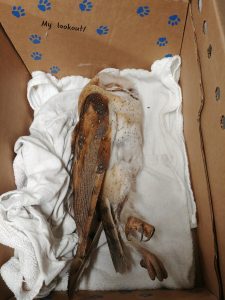Support Us
Since 1979 more than 140,000 animals have been treated by Wildlife Rescue.
Thanks to the support of individuals like you, Wildlife Rescue can provide a lifeline for animals in distress.
Found entangled in netting, this Barn Owl was recently brought to Wildlife Rescue in critical condition, suffering from dehydration and hypothermia. Unfortunately, cases like this are common – netting, such as plastic six-pack rings and even single-use masks can be fatal for wildlife.


With beautiful heart-shaped faces, dark eyes, and long, pale feathers, these majestic birds are a sight to behold.
Sadly, these birds of prey are at risk – they are featured as one of the many species on British Columbia’s red-list. The government of British Columbia’s red, yellow, and blue lists help set priorities for conservation and is a great reference point. It helps to identify which species and ecosystems are in danger or threatened to the point of endangerment.
True to their name, Barn Owls often use barns and other buildings to stay safe, but they also rely on forests and woodlands as well. Some Barn Owls have even been seen in Yankee Stadium! Their diet mainly consists of small mammals such as mice, rats, and rabbits.
Since these birds tend to live in urban areas, they are more at risk of harmful human behaviours. Litter, such as six-pack rings can tangle their limbs up, leaving them struggling as they fight to get out. Their struggles often lead to abrasions, feather destruction, and even broken bones. Similarly, habitat loss is a growing problem for these incredible birds. As urban areas expand, wetlands and foraging areas are lost, making it harder for them to find enough food, and severe winters don’t help. The cold temperatures of winter make it hard for Barn Owls to find adequate food and shelter.
How Can You Help?
If you see an owl that has exposed bone or blood, bugs or insects covering it, no feathers, or an owl that is sleeping, human intervention is required. Please contact our Support Centre for assistance.